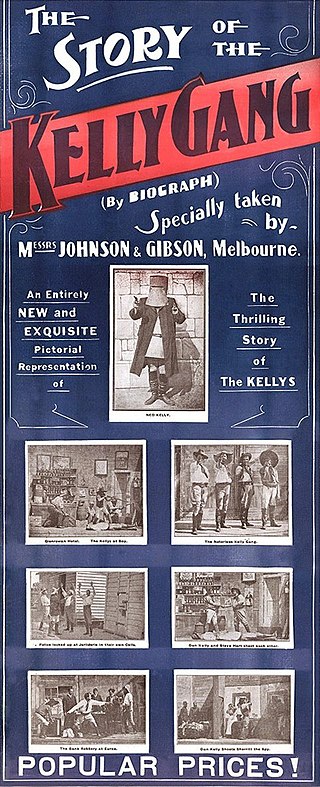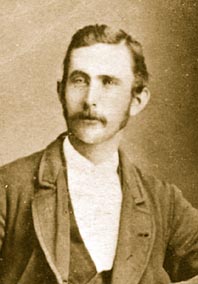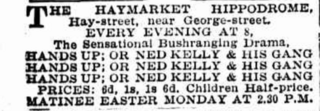Related Research Articles

The Story of the Kelly Gang is a 1906 Australian Bushranger film directed by Charles Tait. It traces the exploits of 19th-century bushranger and outlaw Ned Kelly and his gang, with the film being shot in and around Melbourne. The original cut of this silent film ran for more than an hour with a reel length of about 1,200 metres (4,000 ft), making it the longest narrative film yet seen in the world. It premiered at Melbourne's Athenaeum Hall on 26 December 1906 and was first shown in the United Kingdom in January 1908. A commercial and critical success, it is regarded as the origin point of the bushranging drama, a genre that dominated the early years of Australian film production. Since its release, many other films have been made about the Kelly legend.

Edward Kelly was an Australian bushranger, outlaw, gang leader and convicted police-murderer. One of the last bushrangers, he is known for wearing a suit of bulletproof armour during his final shootout with the police.

True History of the Kelly Gang is a novel by Australian writer Peter Carey, based loosely on the history of the Kelly Gang. It was first published in Brisbane by the University of Queensland Press in 2000. It won the 2001 Booker Prize and the Commonwealth Writers Prize in the same year. Despite its title, the book is fiction and a variation on the Ned Kelly story.

Ned Kelly is a 2003 Australian-British bushranger film based on Robert Drewe's 1991 novel Our Sunshine. Directed by Gregor Jordan, the film's adapted screenplay was written by John Michael McDonagh. The film dramatises the life of Ned Kelly, a legendary bushranger and outlaw who was active mostly in the colony of Victoria. In the film, Kelly, his brother Dan, and two other associates—Steve Hart and Joe Byrne—form a gang of bushrangers in response to acts of police brutality. Heath Ledger stars in the title role, with Orlando Bloom, Naomi Watts and Geoffrey Rush. The film received mixed reviews from critics and grossed $6 million worldwide.

Joseph Byrne was an Australian bushranger of Irish descent. A friend of Ned Kelly, he was a member of the "Kelly Gang" who were declared outlaws after the murder of three policemen at Stringybark Creek. Despite wearing the improvised body armour for which Ned Kelly and his gang are now famous, Byrne received a fatal gunshot during the gang's final violent confrontation with police at Glenrowan, in June 1880.

The Kelly Gang is an Australian feature-length film about the Australian bush ranger, Ned Kelly. The film was released in 1920, and is the second film to be based on the life of Ned Kelly, the first being The Story of the Kelly Gang, released in 1906.

Catherine Ada Kelly was the younger sister of famous Australian outlaw Ned Kelly.

Aaron Sherritt was an associate of the gang of outlaws led by Ned Kelly in Victoria, Australia.

Daniel Kelly was an Australian bushranger and outlaw. The son of an Irish convict, he was the younger brother of the bushranger Ned Kelly. Dan and Ned killed three policemen at Stringybark Creek in northeast Victoria, near the present-day town of Tolmie, Victoria. With two friends, Joe Byrne and Steve Hart, the brothers formed the Kelly Gang. They robbed banks, took over whole towns, and kept the people in Victoria and New South Wales frightened. For two years the Victorian police searched for them, locked up their friends and families, but could not find them. Dan Kelly died during the infamous siege of Glenrowan.

The handwritten document known as the Jerilderie Letter was dictated by Australian bushranger Ned Kelly to fellow Kelly Gang member Joe Byrne in 1879. It is one of only two original Kelly letters known to have survived.
The Glenrowan Affair is a 1951 movie about Ned Kelly from director Rupert Kathner. It was Kathner's final film and stars VFL star Bob Chitty as Kelly. It is considered one of the worst films ever made in Australia.
Harry Southwell was an Australian actor, writer and film director best known for making films about Ned Kelly. He was born in Cardiff, Wales and spent a couple of years in America, where he adapted some short stories by O Henry into two reel films. He worked for Vitagraph in the United States for five years, then moved to Australia in 1919, where he used his experience as a screenwriter to impress investors to back him making features. He set up his own production company in Australia but few of his movies were commercially successful.
When the Kellys Rode is a 1934 Australian film directed by Harry Southwell about Ned Kelly.

Ned Kelly was a 19th-century Australian bushranger and outlaw whose life has inspired numerous works in the arts and popular culture, especially in his home country, where he is viewed by some as a Robin Hood-like figure.
J. J. Kenneally was an Australian journalist and trade unionist. An early populariser of Australian bushranger Ned Kelly and his gang via his book The Inner History of the Kelly Gang and Their Pursuers (1929), he was also one of the original members of the country's Labor Party and later formed his own party.

Stringybark Creek is a small creek in the Wombat Ranges, Victoria, Australia. It is famous for the place where three policemen were murdered on the 28 of October 1878. The policemen, Sergeant Michael Kennedy, Constable Thomas Lonigan, and Constable Michael Scanlan were searching the forest for the Kelly brothers, Ned and Dan Kelly. They were wanted for the attempted murder of another policeman, Constable Fitzpatrick.

True History of the Kelly Gang is a 2019 bushranger film directed by Justin Kurzel, written by Shaun Grant, and based upon the 2000 novel of the same name by Peter Carey. A fictionalised account of the life of bushranger and outlaw Ned Kelly, the film stars George MacKay, Essie Davis, Nicholas Hoult, Charlie Hunnam and Russell Crowe.

In 1879, Australian bushranger and outlaw Ned Kelly devised a plan to create bulletproof armour and wear it during shootouts with the police. He and other members of the Kelly gang—Joe Byrne, Steve Hart, and brother Dan Kelly—had their own armour suits and helmets crafted from plough mouldboards, either donated by sympathisers or stolen from farms. The boards were heated and then beaten into shape over the course of several months, most likely in a crude bush forge and possibly with the assistance of blacksmiths. While the suits successfully repelled bullets, their heavy weight made them cumbersome to wear, and the gang debated their utility.

Hands Up, or Ned Kelly and His Gang is a 1900 Australian play by Edward Irham Cole about Ned Kelly.

Ostracised, or Every Man's Hand Against Them is a 1881 Australian play about Ned Kelly by E.C. Martin. It was the first straight dramatisation of the Kelly story from an Australian writer although there had been one in London. The play was banned in Sydney.
References
- ↑ "A BUSH DRAMA". The Advertiser . Adelaide: National Library of Australia. 14 September 1923. p. 26. Retrieved 29 July 2012.
- ↑ "Filmography", Cinema Papers, June–July 1980 p175
- 1 2 "LAMBERT'S PICTURES". Albany Advertiser . WA: National Library of Australia. 24 September 1924. p. 4. Retrieved 29 July 2012.
- ↑ "TROOPERS AND BUSHRANGERS". The Advertiser . Adelaide: National Library of Australia. 17 September 1923. p. 10. Retrieved 29 July 2012.
- 1 2 Andrew Pike and Ross Cooper, Australian Film 1900–1977: A Guide to Feature Film Production, Melbourne: Oxford University Press, 1998, 118.
- 1 2 "POLICE PROHIBIT FILM "GLORIFYING CRIMINALS"". The Argus . Melbourne: National Library of Australia. 16 May 1934. p. 9. Retrieved 29 July 2012.
- ↑ "AMUSEMENTS". The Sydney Morning Herald . National Library of Australia. 23 May 1923. p. 15. Retrieved 29 July 2012.
- ↑ "THEATRE ROYAL". The Barrier Miner . Broken Hill, NSW: National Library of Australia. 27 September 1923. p. 2. Retrieved 29 July 2012.
- ↑ ""THE BELLS" FILM". The Daily News . Perth: National Library of Australia. 20 June 1928. p. 8 Edition: HOME (FINAL) EDITION. Retrieved 29 July 2012.
